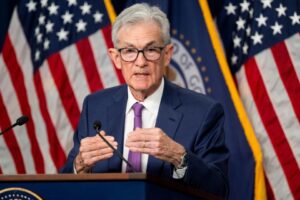
U.S. stocks traded lower mid-morning Thursday, led by technology stocks, as investors parsed mixed corporate earnings reports and economic data in the wake of a drop in Asian markets with U.S.-China tensions a factor also.
What are major indexes doing?
The Dow Jones Industrial Average DJIA, -0.00% was down 7 points, or 0.3%, to trade near 26,799, while the S&P 500 SPX, -0.43% was down about 18 points, 0.6%, at 3,209. The Nasdaq Composite COMP, -1.21% was off 136 points, 1.3%, near 10,413.
The Dow on Wednesday rose 227.51 points, or 0.9%, to end at 26,870.10, while the S&P 500 advanced 29.04 points, or 0.9%, to close at 3,226.56. The Nasdaq Composite gained 61.91 points, or 0.6%, to finish at 10,550.49.
What’s driving the market?
Technology stocks weighed on the benchmark stock indexes, led by Amazon AMZN, -2.36% and Microsoft MSFT, -1.95% . Technology stocks had been the been the best-performing sector this year on prospects for growth during the coronavirus pandemic.
The U.S. corporate earnings reporting season has so far largely cheered investors with results from big banks. Morgan Stanley MS, +3.46% on Thursday reported second-quarter profit that beat analyst expectations, led by strength in investment banking and trading, but Bank of America Corp. BAC, -1.91% shares tumbled in premarket trade after the bank said it would boost its loan-loss provisions.
“Despite today’s weakness, the market is doing quite well,” said Randy Frederick, vice president of trading and derivatives at the Schwab Center for Financial Research. Frederick noted that the S&P 500 had briefly erased its losses for the year to date. With the bar set so low for second-quarter earnings, it’s possible more positive surprises could even result in a boost for stocks, he said.
U.S. economic data was also mixed on Thursday. First-time jobless claims for the week ending July 11 were only lower by 10,000 compared with the prior week: at 1.3 million, a much more muted recovery than the consensus of 1.24 million from economists surveyed by MarketWatch.
A separate report showed that retail sales roared back in June, rising 7.5%, compared with the 5.4% increase that had been forecast. And the July Philadelphia Fed index also beat expectations: falling only to 24.1 from 27.5, better than the 20 level expected. But the jobless claims data are more recent, and may signal cracks in the nascent economic recovery as states move to reimpose shutdown measures.
Meanwhile, a measure of homebuilder confidence surged 14 points to 72 in July, regaining pre-pandemic levels, and business inventories slipped 2.3% in May, in line with economists’ expectations.
Global equities were under pressure after Chinese stocks suffered their biggest one-day loss since the start of the coronavirus pandemic overnight. Analysts said softer-than-expected consumer economic data from Beijing was weighing on stocks and other risky assets, as was a continued rise in tensions between Beijing and Washington may have shaken investor sentiment.
The Trump administration is weighing a ban that would prevent members of the Chinese Communist Party and their families from traveling to the U.S. while the Trump administration said Wednesday that it would ban travel for employees of Chinese technology group Huawei and other companies it deems complicit in helping Beijing crack down on human rights in the country. China recently imposed travel restrictions on some U.S. officials, including Senators Marco Rubio and Ted Cruz.
The U.S.-China tensions overshadowed upbeat economic data that saw China’s second-quarter gross domestic product expand 3.2% from a year ago, beating an analyst consensus estimate of 2%, and marking a bounce after a 6.8% rout in the first quarter. Analysts said other data from China, including an unexpected fall in retail sales, were also concerning.
“China was the first nation to suffer from COVID-19 and go into lockdown. They are ahead of the West on the recovery curve. However, the cautious consumer could well be a signal of what we can expect across the U.K. or the U.S.,” said Fiona Cincotta, market analyst at CityIndex, in a note.
No matter the geopolitical backdrop, “the virus is the greatest part of the story,” said Schwab’s Frederick. Flare-ups in U.S. case counts, news about hospitals being overwhelmed, “all of those things shock people a lot. It causes people to go back into their homes, be more hesitant,” he said in an interview.
Read:Here’s the good news and bad news about China GDP data
As widely expected, the European Central Bank made no changes to its asset-buying program or to interest rates at a meeting Thursday.
Which companies are in focus?
- Twitter Inc. TWTR, -1.36% shares slumped more than 3% in early action after accounts belonging to top U.S. executives, lawmakers and celebrities were compromised Wednesday afternoon in what appeared to be an attempt to siphon bitcoin from social-media followers. Twitter said it believed the incident was “a coordinated social engineering attack by people who successfully targeted some of our employees with access to internal systems and tools.”
- Charles Schwab Corp. SCHW, +0.58% on Thursday reported profits that beat expectations but revenue that missed. Shares fell nearly 1% in morning trade.
- Bank of America Corp. BAC, -1.91% shares were 2.5% lower in morning trade after the bank delivered results that topped Wall Street expectations.
- Domino’s Pizza Inc. DPZ, -0.00% shares were lower even after the pizza chain reported quarterly results that trounced analyst expectations. U.S. same-store sales grew 16.1%, management said.
- Johnson & Johnson JNJ, -0.12% Shares of fell Thursday after the drug and consumer health products company reported second-quarter profit and sales that beat expectations, and raised its full-year outlook. The company expects the Phase 1 trial for its COVID-19 vaccine candidate to begin next week, its CFO told CNBC.
- Abbot Laboratories ABT, -0.51% shares fell even after the company reported revenue and profit that beat analyst expectations, and offered rosy guidance for the coming year.
What are other markets doing?
The Shanghai Composite Index SHCOMP, -4.49% fell 4.5% for its biggest one-day loss since Feb. 3, according to Dow Jones Market Data, while the CSI 300 Index 000300, -4.81% dropped 4.8%. Japan’s Nikkei 225 Index NIK, -0.76% fell 0.8%, while the Hang Seng Index HSI, -2.00% in Hong Kong lost 2%.
The pan-European Stoxx 600 Europe Index SXXP, -0.39% fell 0.6%, while London’s FTSE 100 Index UKX, -0.33% was off 0.5%.
The yield on the 10-year Treasury note TMUBMUSD10Y, 0.609% was off about 3 basis points at 0.604% as investors pivoted away from riskier assets. Bond yields and prices move in opposite directions.
The ICE U.S. Dollar Index DXY, -0.16%, a measure of the U.S. currency against a basket of six major rivals, fell 0.1%.
Oil futures CL.1, -0.80% were under pressure, down 0.9% to about $40.85 a barrel as investors reconsidered the durability of the budding economic expansion. Meanwhile, gold GC00, -0.24% also pulled back. Gold for August delivery on Comex was down $7.20, or 0.4%, at $1,806.60 an ounce.
Related:China’s stock market just jumped 6%. This is a good thing and Westerners should be glad. No, really.
















Add Comment